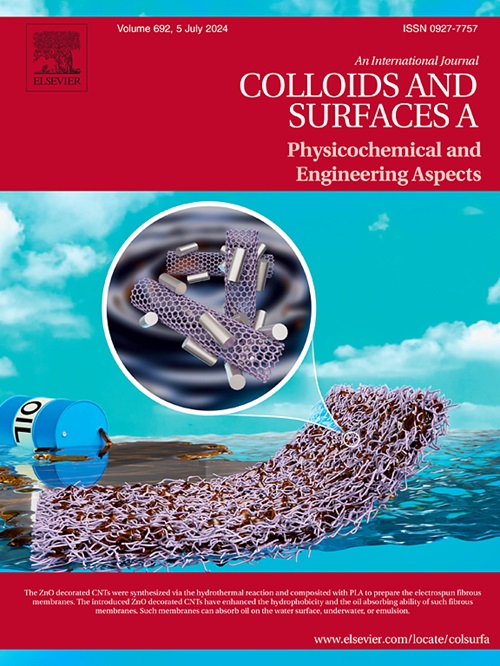Flotation mechanism of chalcopyrite separation from sphalerite and pyrite using 2-aminobenzothiazole
IF 4.9
2区 化学
Q2 CHEMISTRY, PHYSICAL
Colloids and Surfaces A: Physicochemical and Engineering Aspects
Pub Date : 2025-06-24
DOI:10.1016/j.colsurfa.2025.137584
引用次数: 0
Abstract
The development of eco-friendly and effective collectors for sulfide mineral flotation is a key area of research. This study explores the selectivity of 2-Aminobenzothiazole (CS-1) as a novel collector for the flotation separation of chalcopyrite from sphalerite and pyrite, compared to the conventional collector, sodium ethyl xanthate (SEX). Micro-flotation tests showed that CS-1 effectively floated chalcopyrite with a recovery of over 90 % at pH 8, while flotation of sphalerite and pyrite was minimal (15.58 % and 13.54 %, respectively). Zeta potential and X-ray photoelectron spectroscopy analyses revealed that CS-1 adsorbs onto chalcopyrite, forming C-S-C functional groups that enhance chemical bonding between CS-1 and chalcopyrite. Density functional theory calculations confirmed the selective interaction of CS-1 with the Fe sites on the chalcopyrite, with minimal/negligible interactions on either sphalerite or pyrite. These findings highlight the distinct flotation behavior of chalcopyrite relative to sphalerite and pyrite. The selective adsorption of CS-1 on chalcopyrite surfaces under mildly alkaline conditions drives its distinct flotation response, suggesting the potential of CS-1 for the efficient separation of chalcopyrite from pyrite and sphalerite.
2-氨基苯并噻唑浮选黄铜矿分离闪锌矿和黄铁矿的机理
开发环保高效的硫化矿物浮选捕收剂是当前研究的重点。研究了2-氨基苯并噻唑(CS-1)作为新型捕收剂在黄铜矿、闪锌矿和黄铁矿浮选分离中的选择性,并与传统捕收剂乙基黄药钠(SEX)进行了比较。微浮选试验结果表明,CS-1在pH为8时可有效浮选黄铜矿,回收率达90% %以上,而对闪锌矿和黄铁矿的浮选效果较差(分别为15.58 %和13.54 %)。Zeta电位和x射线光电子能谱分析表明,CS-1吸附在黄铜矿上,形成C-S-C官能团,增强了CS-1与黄铜矿之间的化学键合。密度泛函理论计算证实了CS-1与黄铜矿上铁位点的选择性相互作用,与闪锌矿或黄铁矿的相互作用极小或可忽略。这些发现突出了黄铜矿相对于闪锌矿和黄铁矿的独特浮选行为。CS-1在温和碱性条件下对黄铜矿表面的选择性吸附驱动了其独特的浮选反应,表明CS-1具有从黄铁矿和闪锌矿中高效分离黄铜矿的潜力。
本文章由计算机程序翻译,如有差异,请以英文原文为准。
求助全文
约1分钟内获得全文
求助全文
来源期刊
CiteScore
8.70
自引率
9.60%
发文量
2421
审稿时长
56 days
期刊介绍:
Colloids and Surfaces A: Physicochemical and Engineering Aspects is an international journal devoted to the science underlying applications of colloids and interfacial phenomena.
The journal aims at publishing high quality research papers featuring new materials or new insights into the role of colloid and interface science in (for example) food, energy, minerals processing, pharmaceuticals or the environment.

 求助内容:
求助内容: 应助结果提醒方式:
应助结果提醒方式:


